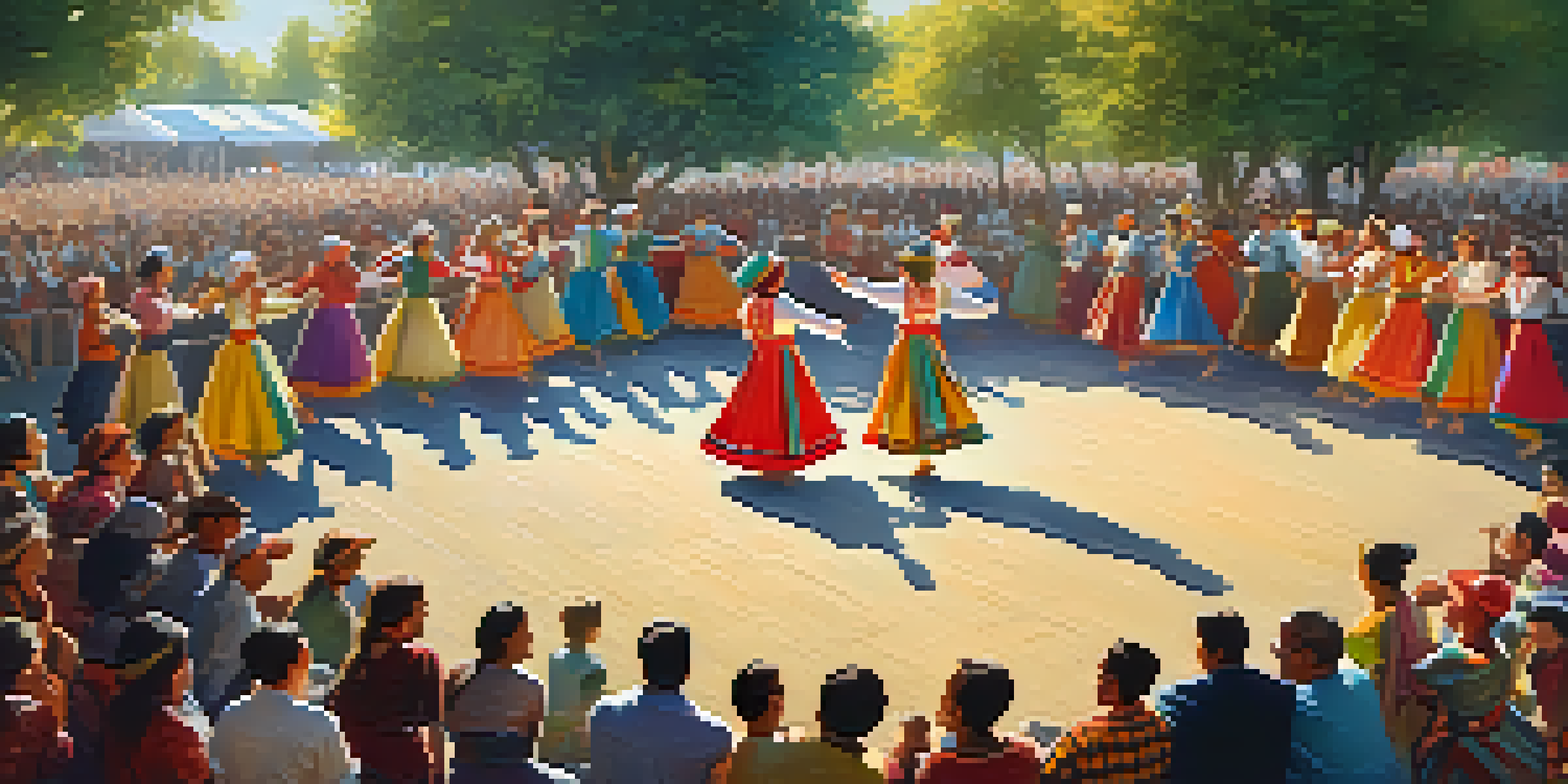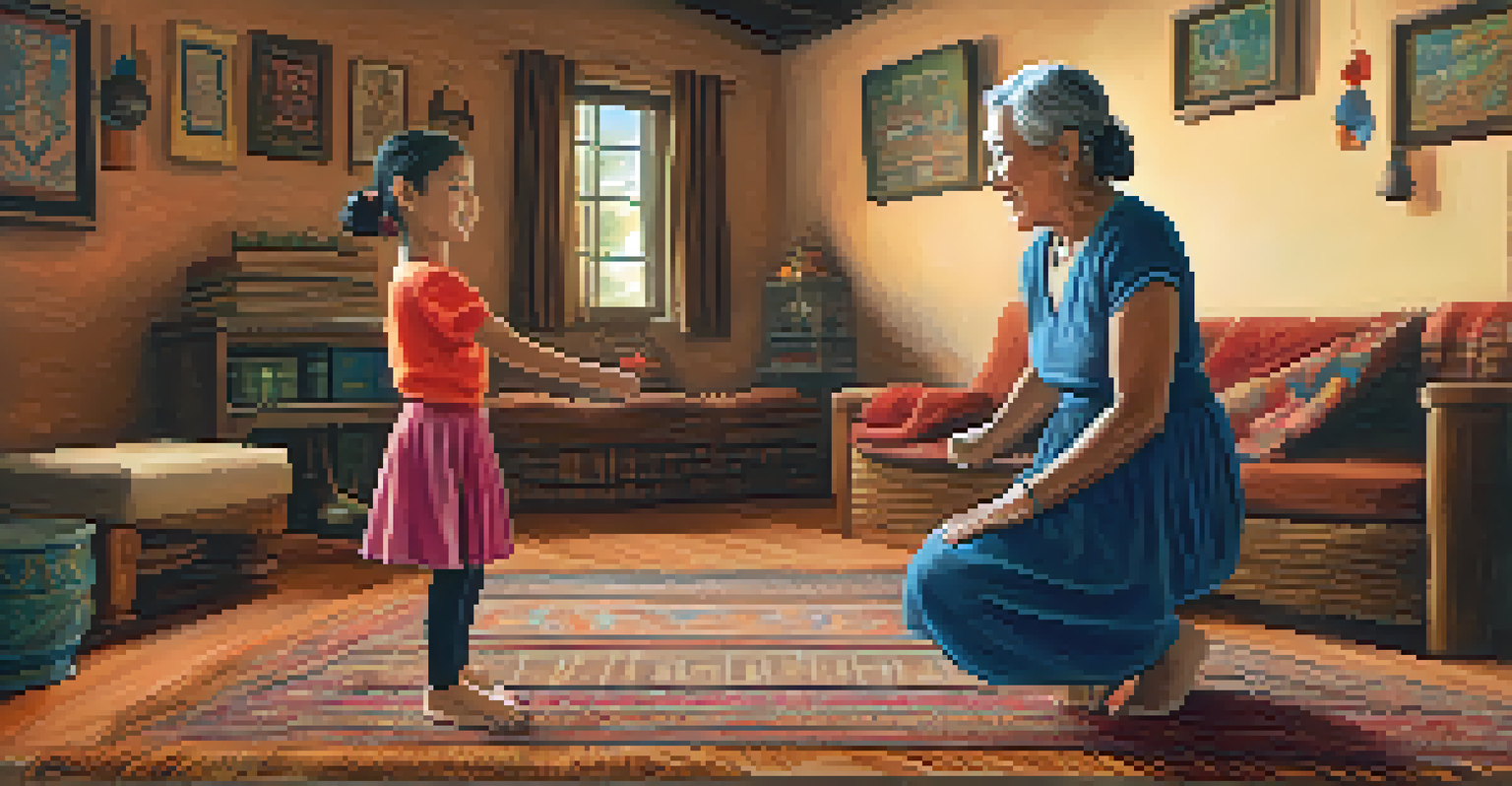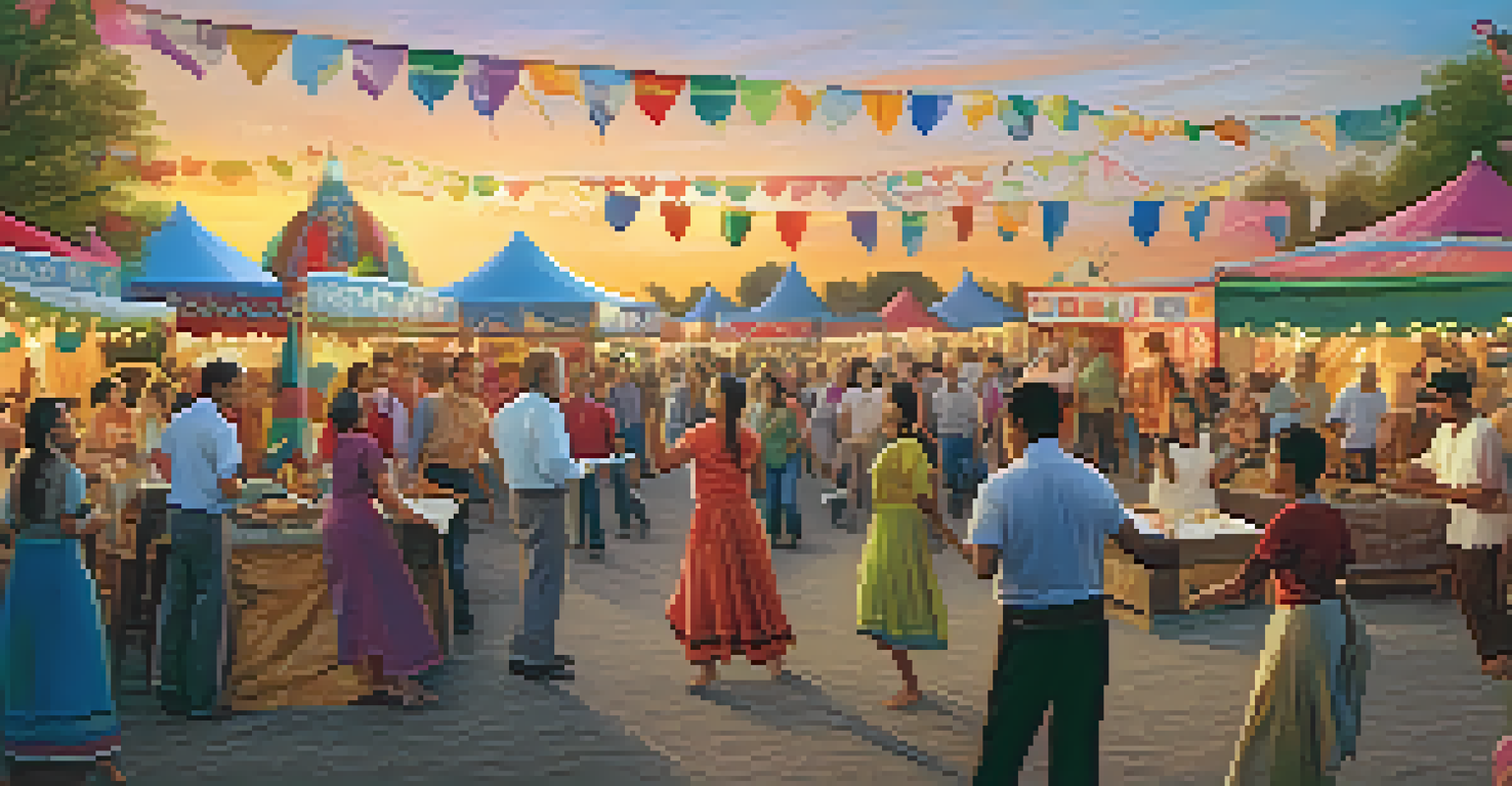The Connection Between Folk Dance and Community Bonding

Understanding Folk Dance as a Cultural Expression
Folk dance is a vibrant form of cultural expression that reflects the traditions, stories, and values of a community. These dances are often passed down through generations, embodying the history and spirit of a people. By participating in folk dance, individuals connect not only with their heritage but also with the larger community that shares these customs.
Dance is the hidden language of the soul.
Each folk dance tells a story, whether it’s about agricultural practices or historical events, creating a rich tapestry of shared experiences. This storytelling aspect enhances the bond between dancers, as they collectively engage in a narrative that is much bigger than themselves. It’s like a living history lesson that brings everyone together in celebration of their roots.
Moreover, folk dances often evolve to include contemporary themes while still honoring traditional elements. This adaptability keeps the dance relevant and engaging for new generations, fostering a sense of belonging and identity. Ultimately, folk dance serves as a bridge connecting the past with the present, uniting community members through shared cultural experiences.
The Role of Folk Dance in Community Gatherings
Community gatherings are often enriched by the presence of folk dance, transforming ordinary events into lively celebrations. Whether at festivals, weddings, or local fairs, folk dance invites everyone to participate, fostering a sense of inclusivity. This communal aspect allows individuals to connect with one another, breaking down barriers and building friendships.

When people come together to dance, they share laughter, joy, and even a few missteps, creating lasting memories. These shared experiences, no matter how simple, help to strengthen the social fabric of the community. It’s akin to a potluck dinner, where everyone brings a dish to share; in this case, people bring their energy and enthusiasm to the dance floor.
Folk Dance Connects Communities
Folk dance fosters inclusivity and social bonds within communities, turning gatherings into lively celebrations.
Additionally, folk dance serves as a platform for cultural exchange, where diverse communities can share their unique styles and traditions. This not only broadens individual perspectives but also enriches the community as a whole. As people learn from one another, they foster mutual respect and understanding, ultimately enhancing community bonds.
Folk Dance as a Tool for Social Cohesion
Folk dance goes beyond mere entertainment; it acts as a powerful tool for social cohesion. By inviting community members to join in a common activity, folk dance breaks down social barriers and promotes teamwork. This collective participation builds trust and camaraderie, essential ingredients for a strong community.
Folk dance is a form of social expression that transcends barriers and brings people together.
When individuals dance together, they engage in a shared rhythm that transcends language and cultural differences. It creates a sense of belonging, making everyone feel valued and included. In this way, folk dance can be likened to a shared meal, where everyone contributes to and enjoys the collective experience.
Moreover, folk dance can play a significant role in addressing social issues within communities. By highlighting themes of unity and cooperation, it encourages dialogue and collaboration among diverse groups. This can lead to more cohesive communities where individuals feel empowered to work towards common goals.
The Emotional Benefits of Participating in Folk Dance
Participating in folk dance is not only a fun activity; it also offers numerous emotional benefits. Engaging in dance can alleviate stress, boost mood, and enhance overall well-being. The act of moving rhythmically to music releases endorphins, the body’s natural feel-good chemicals, turning a simple dance session into a joyful experience.
Additionally, the communal aspect of folk dance fosters a sense of support and belonging, which can be particularly beneficial for individuals facing personal struggles. When surrounded by others who share similar experiences and values, individuals can find solace and encouragement. It’s like having a second family that lifts you up through shared joy and movement.
Emotional Benefits of Dance
Participating in folk dance enhances emotional well-being and provides a supportive environment for individuals.
Furthermore, the expressive nature of folk dance allows individuals to convey emotions that words sometimes fail to express. It serves as an outlet for creativity and self-expression, enabling dancers to connect with their inner selves while also connecting with others. This combination of emotional release and community support makes folk dance a powerful tool for personal growth.
Folk Dance in Promoting Intergenerational Connections
Folk dance is a unique medium that brings together different generations, creating a bridge between young and old. When families participate in folk dance together, they share stories and traditions, fostering understanding and respect. This intergenerational connection is crucial for preserving cultural heritage and ensuring that traditions continue to thrive.
During folk dance events, younger participants often learn from their elders, gaining insight into the history and significance behind each movement. This transmission of knowledge helps to strengthen familial bonds and reinforces the importance of community traditions. It’s akin to storytelling around a campfire, where each generation contributes to the narrative.
Moreover, the joy of dancing together can create lasting memories that families cherish for years to come. These shared experiences not only deepen relationships but also instill a sense of pride in one’s cultural identity. As young dancers look to their elders for guidance, they also become ambassadors of their heritage, ensuring that it is celebrated for years to come.
Folk Dance and its Impact on Local Identity
Folk dance plays a significant role in shaping and expressing local identity. It provides communities with a sense of pride and belonging, as they celebrate their unique cultural heritage through dance. This connection to local identity helps to foster a strong sense of community among residents, reinforcing the idea that they are part of something greater than themselves.
Moreover, folk dance can attract visitors and tourists, highlighting the uniqueness of a community’s cultural offerings. Events centered around folk dance can serve as a platform for showcasing local traditions, crafts, and cuisine, ultimately boosting local economies. This cultural spotlight can lead to increased community engagement and investment in preserving traditions.
Preserving Cultural Heritage
Folk dance bridges generations, ensuring the transmission of cultural traditions and fostering pride in community identity.
In essence, folk dance becomes a living representation of a community's identity, reflecting its values, history, and aspirations. As communities embrace their folk dance traditions, they cultivate a sense of belonging that resonates with both residents and visitors alike. This celebration of local identity enhances community pride and encourages collective ownership of cultural heritage.
The Future of Folk Dance in Community Building
As society continues to evolve, the future of folk dance remains bright, particularly in the realm of community building. With the rise of technology and social media, folk dance is finding new platforms for expression and connection. Virtual dance events and online workshops are making it easier for communities to engage with folk dance, even from a distance.
These modern adaptations of folk dance not only preserve tradition but also attract younger generations who may not have been exposed to it otherwise. By embracing innovation while honoring the past, communities can ensure that folk dance remains relevant and appealing. This blend of tradition and modernity can be likened to a classic recipe that gets a contemporary twist while still retaining its delicious essence.

Looking ahead, it’s essential for communities to continue fostering environments where folk dance can thrive. By encouraging participation, collaboration, and creativity, communities can strengthen their bonds and cultivate a vibrant cultural landscape. The future of folk dance is not just about preserving the past; it’s about building a shared future filled with unity, joy, and connection.